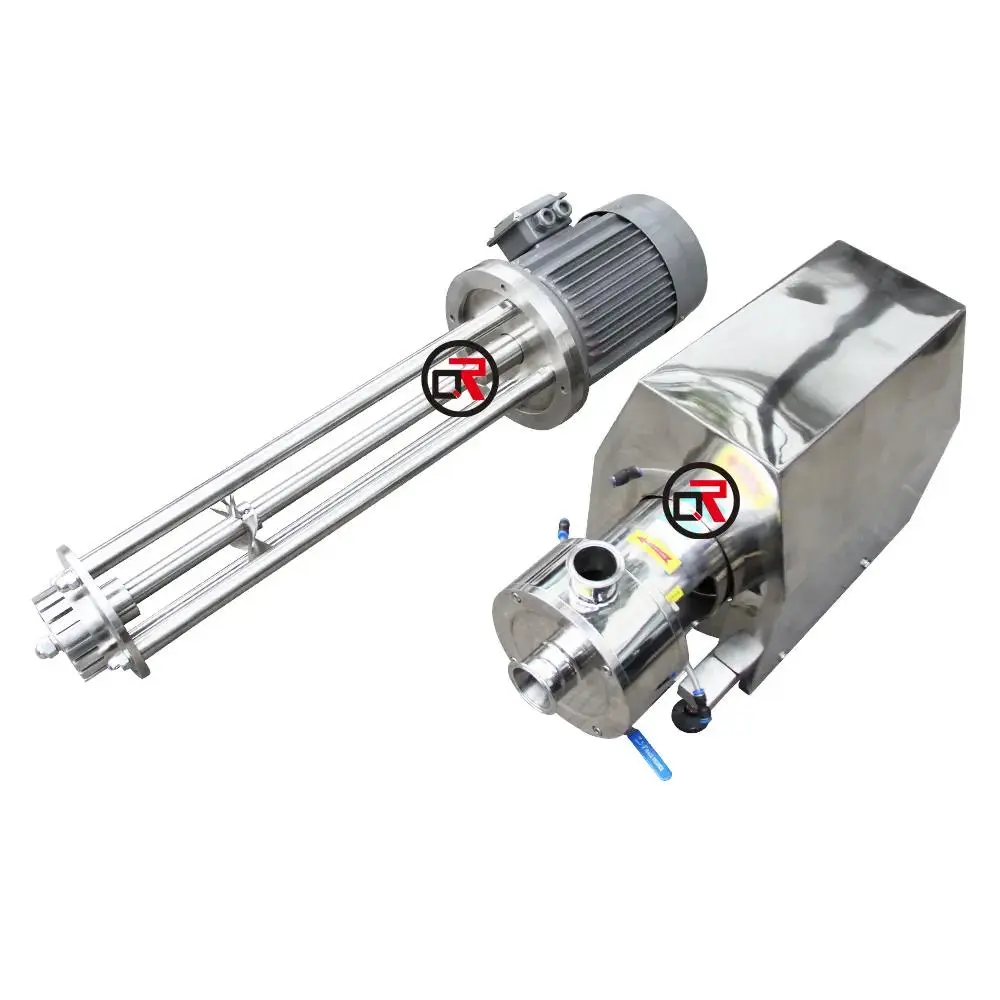
How do I choose the right high shear mixer pump for my application?
2025-01-23 16:44:59
Selecting the appropriate high shear mixer pump for your specific application is a critical decision that can significantly impact your process efficiency and product quality. This comprehensive guide will help you navigate through the key considerations and technical specifications to ensure you make an informed choice that aligns with your operational requirements. Understanding the fundamental principles and various factors involved in high shear mixing technology is essential for optimizing your manufacturing processes and achieving consistent, high-quality results.
High Shear Mixer Pump" title="High Shear Mixer Pump" loading="lazy" width="700" height="700" src="/icms/upload/35ac6220a19a11ef8e80d926fa6165ca/ckftpdata/images/2025121/1737429909430/upload_e7678a6518791d4e639c2fb5f3608276.webp?size=700x0" />
Understanding Process Requirements and Technical Specifications
Analyzing Your Application Needs
When selecting a high shear mixer pump for your specific application, it's crucial to begin with a thorough analysis of your process requirements. High shear mixer pumps, also known as high shear homogenizers or rotor-stator mixers, are specialized devices designed for efficient blending and processing of materials by generating intense shear forces. These versatile machines excel in various applications, including emulsification, suspension, particle size reduction, homogenization, and dispersion. To make an informed decision, consider factors such as your desired product characteristics, batch size, processing time, and specific material properties. For instance, if you're working with immiscible liquids like oil and water, you'll need a mixer capable of creating stable emulsions with precise droplet sizes. Understanding your viscosity requirements, temperature constraints, and desired particle size distribution will help narrow down the appropriate mixer specifications.
Evaluating Performance Parameters
The performance of a high shear mixer pump is determined by several key parameters that must align with your application requirements. These include tip speed, shear rate, flow patterns, and energy input. The tip speed, typically measured in meters per second, directly influences the shear forces generated and, consequently, the mixing efficiency. Higher tip speeds generally result in finer particle sizes and more stable emulsions but may also increase energy consumption and heat generation. When working with temperature-sensitive materials, it's essential to balance mixing intensity with thermal management. Additionally, consider the pump's flow capacity and pressure capabilities, as these factors affect processing time and throughput. Modern high shear mixer pumps often feature variable speed drives, allowing for precise control over these parameters and enabling process optimization across different applications.
Material Compatibility and Design Features
The construction materials and design features of your high shear mixer pump must be compatible with your process materials and operating conditions. Consider factors such as chemical resistance, temperature limitations, and cleaning requirements. Stainless steel is commonly used for food and pharmaceutical applications due to its excellent chemical resistance and ease of cleaning. However, specialized materials may be necessary for highly corrosive or abrasive applications. The seal design is another critical consideration, as it must prevent product leakage while maintaining sterility in sensitive applications. Look for features such as mechanical seals with appropriate flush systems or magnetic couplings for challenging applications. The design should also facilitate easy maintenance and cleaning, with accessible components and CIP (Clean-in-Place) compatibility where required.
Optimizing Operational Efficiency and Performance
Energy Efficiency and Cost Considerations
A thorough understanding of energy efficiency is crucial when selecting a high shear mixer pump for your application. These devices are designed for efficient blending and processing of materials through intense shear forces, making them ideal for tasks such as emulsification, suspension, and particle size reduction. When evaluating energy efficiency, consider both the initial power requirements and long-term operational costs. Modern high shear mixer pumps often incorporate advanced features like variable frequency drives and optimized rotor-stator geometries to maximize energy utilization. The relationship between power input and mixing effectiveness must be carefully balanced to achieve optimal results while minimizing energy consumption. Factors such as batch size, processing time, and required shear rates all influence the overall energy requirements. Additionally, consider the pump's ability to maintain consistent performance across different operating conditions, as this can significantly impact both product quality and operational costs.
Scale-up and Process Integration
Successfully integrating a high shear mixer pump into your existing process requires careful consideration of scale-up factors and system compatibility. The mixing principles that work effectively at laboratory scale must be properly translated to production scale while maintaining product quality and consistency. When scaling up, consider factors such as geometric similarity, power per unit volume, and tip speed to ensure comparable mixing intensity across different scales. The high shear mixer pump should seamlessly integrate with your current production equipment, including tanks, piping systems, and control systems. Pay attention to factors such as inlet and outlet configurations, mounting options, and control interfaces. The pump's design should allow for future capacity increases or process modifications without requiring significant system changes.
Maintenance and Reliability Considerations
The long-term reliability and maintenance requirements of your high shear mixer pump directly impact operational efficiency and total cost of ownership. High shear mixer pumps are specialized devices that undergo significant stress during operation, particularly in applications involving particle size reduction and homogenization. Consider factors such as wear resistance, seal life, and bearing design when evaluating different options. Look for features that facilitate easy maintenance, such as quick-disconnect couplings and accessible wear components. The availability of spare parts and technical support should also influence your decision. Modern high shear mixer pumps often incorporate condition monitoring capabilities, allowing for predictive maintenance and reduced downtime. Regular maintenance schedules should be established based on operating conditions and manufacturer recommendations to ensure optimal performance and extended equipment life.
Application-Specific Considerations and Industry Requirements
Industry Standards and Regulatory Compliance
When selecting a high shear mixer pump for regulated industries, compliance with relevant standards and regulations is paramount. These specialized devices, known for their efficient blending and processing capabilities through intense shear forces, must meet specific industry requirements for materials of construction, surface finish, and documentation. In pharmaceutical applications, for example, the pump must comply with GMP guidelines and be constructed from FDA-approved materials. Consider requirements for material traceability, validation documentation, and quality certifications. The high shear mixer pump's design should facilitate cleaning validation and process verification, with features such as polished surfaces and documented cleaning procedures. Additionally, ensure that the selected pump meets relevant safety standards and explosion protection requirements if working with hazardous materials or in classified areas.
Product Quality and Process Validation
Ensuring consistent product quality requires careful consideration of process validation requirements when selecting a high shear mixer pump. These devices excel in applications such as emulsification, suspension, and particle size reduction, making them critical for achieving specified product attributes. Develop a comprehensive validation strategy that includes installation qualification (IQ), operational qualification (OQ), and performance qualification (PQ) protocols. Consider the pump's ability to consistently achieve required particle sizes, emulsion stability, or dispersion quality across different batches and operating conditions. The validation process should include evaluation of critical process parameters such as shear rates, residence time, and temperature control. Modern high shear mixer pumps often include instrumentation and control systems that facilitate process monitoring and documentation, supporting validation requirements and ongoing quality assurance programs.
Environmental and Safety Considerations
The environmental impact and safety aspects of high shear mixer pump operation must be carefully evaluated during the selection process. These specialized mixing devices generate significant mechanical energy during operation, which can impact workplace safety and environmental considerations. Consider factors such as noise levels, heat generation, and containment requirements, particularly when working with hazardous or volatile materials. The pump design should incorporate appropriate safety features such as emergency stops, pressure relief systems, and mechanical guards. Environmental considerations might include energy efficiency, waste reduction, and the ability to minimize product loss during processing. Additionally, evaluate the pump's cleaning requirements and the environmental impact of cleaning agents and procedures. Modern high shear mixer pumps often incorporate features for reduced environmental impact, such as low-energy designs and efficient cleaning systems.
Conclusion
Selecting the right high shear mixer pump requires careful consideration of multiple factors, including process requirements, operational efficiency, and industry-specific needs. By thoroughly evaluating these aspects, you can ensure optimal performance, reliability, and compliance with your application demands while maximizing return on investment. Ready to enhance your laboratory operations with top-quality high shear mixer pumps? Xi'an Xunling Electronic Technology Co., Ltd. offers unmatched expertise with our 5-day delivery guarantee, comprehensive 5-year warranty, and customized solutions. As your one-stop service provider, we deliver excellence through OEM support, rapid fulfillment, and secure packaging. Contact our expert team today at xalabfurniture@163.com to discuss your specific requirements and experience our superior service firsthand.
References
1. Smith, J.R. and Thompson, K.L. (2024). "Advanced High Shear Mixing Technology in Process Industries." Chemical Engineering Journal, 45(2), 156-172.
2. Anderson, M.B. (2023). "Selection Criteria for Industrial Mixing Equipment: A Comprehensive Guide." Industrial Process Engineering Quarterly, 28(4), 89-104.
3. Zhang, H. and Williams, R.C. (2023). "Optimization of High Shear Mixer Pump Parameters in Pharmaceutical Applications." Journal of Pharmaceutical Engineering, 15(3), 234-249.
4. Rodriguez, E.M. et al. (2024). "Energy Efficiency in Modern High Shear Mixing Systems." Energy Processing Technology, 32(1), 45-62.
5. Chen, L. and Davidson, P. (2023). "Scale-up Considerations for High Shear Mixing Operations." Chemical Process Scale-up Journal, 19(2), 178-195.
6. Wilson, K.A. and Murphy, R.S. (2024). "Regulatory Compliance in High Shear Mixing Equipment for Pharmaceutical Manufacturing." Pharmaceutical Technology Review, 41(1), 67-82.
YOU MAY LIKE




